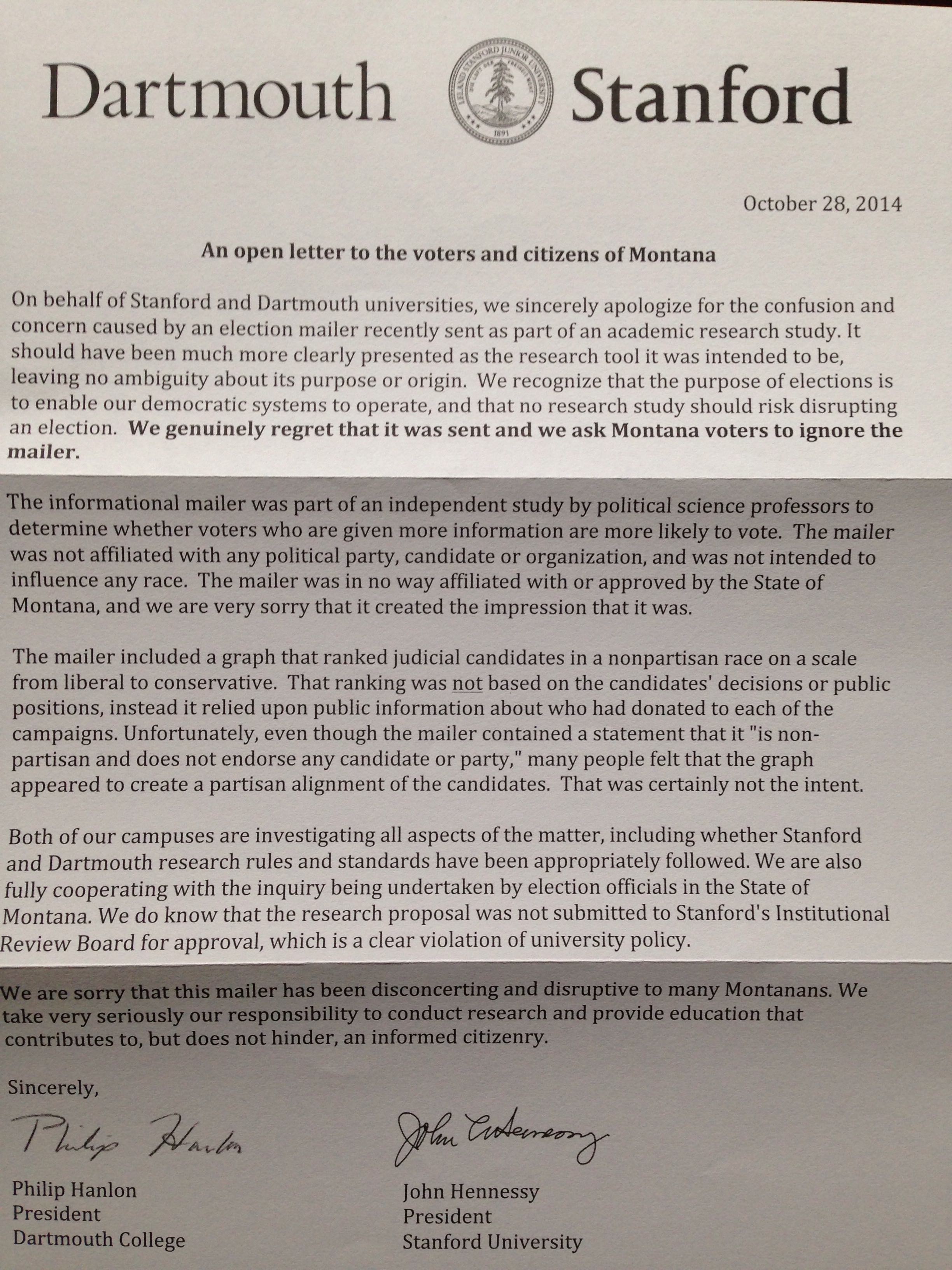
He got it in the mail and writes, “I don’t recall receiving the original mailer, but I probably would have just tossed it with the rest of the election mail I was getting.”
P.S. Wouldn’t it be funny if this letter was actually sent from someone in the political science department at Montana State University, as an experiment to see people’s reactions after getting this letter.
No, I guess it couldn’t be that. They used the official Stanford seal; I think you’re only allowed to do that if you’re actually from Stanford.
Oh, it’s real: that’s John’s signature and his style. more locally, not just Montana.
From the Merc News article: “It is not clear how the ideological ratings were devised.”
That’s one thing that jumped out at me when Andrew posted the flyer a few days ago. How were those ratings established? Contrary to Hanlon and Hennessy’s suggestion that the flyer was intended to provide information to the voters it sure looks like it was intended to stimulate a “Liberal good. Conservative evil.” (or vice versa) response. If the authors of the flyer were interested in providing the voter with meaningful information they why didn’t they provide some information on how the candidates decided cases which came before them?
PS If were the Montana AG I’d look into prosecuting the responsible parties for unauthorized use of the state seal, i.e., attempting to make the flyer look like an official state document.
> “Unfortunately, even though the mailer contained a statement that it ‘is non-partisan and does not endorse any candidate or party,’ many people felt that the graph appeared to create a partisan alignment of the candidates. That was certainly not the intent.”
And in a separate interview, Hanlon and Hennessy stated their surprise that many people associate The William Tell Overture with The Lone Ranger.
My favorite part of this whole drama is that Stanford and Dartmouth apparently only sent the apology letter to the treatment group. The treatment-control difference in voting behavior is going to be so fascinating! Obviously, the treatment in this case is an especially obscure black box — imputed ideological positions, state seals, mild uproar on poli sci blogs, and then a bizarro letter from faraway universities. Can’t wait to see what happens… if the results ever see the light of day.
It’s interesting that the apology letter says the study was NOT approved by the IRB. I wonder if there will be any backlash on the researchers for this move.
“We do know that the research proposal was not submitted to Stanford’s IRB for approval, which is a clear violation of university policy.”
This sounds great, but reading Stanford’s own guidance, it is not that clear cut, at least to me.
http://humansubjects.stanford.edu/research/documents/HSresearch_definitionsAID03H11.pdf
This really hinges on whether the data obtained are “about” the individuals. Is it reasonable for the investigators to conclude that the (aggregate) data they were analyzing were not *about* the individuals? If so, it’s not HSR and need not go through the IRB.
Stanford policy does also state that if there is any doubt, it should go through the IRB. This still looks a bit like the administration throwing the investigators under the bus.
http://humansubjects.stanford.edu/research/documents/HSresearch_applicationAPP03H08.doc
It’s a given in social science research that the default is to review or at minimum to seek a “research determination” that can find that something is not human subjects research or not research at all. In this case there was direct contact with humans so there is no ambiguity at all about whether it was human subjects research.
I cannot understand how anyone graduates from a doctoral program in social sciences without understanding this topic in detail–we require all of our undergraduates to undergo the university provided training and to read and discuss the Belmont Report in a core class.
This case is a complete example of how IRB review protects researchers. Things like including the state seal would never pass muster for any semiconscious IRB nor would the ridiculous sample size. They would have been forced to think carefully about issues of potential impact on the election results. And there are more. In addition to protecting research participants, IRBs keep researchers from doing stupid things that end up destroying careers and embarrassing their institutions.
Pingback: Social research is not the same as health research: Macartan Humphreys gives new guidelines for ethics in social science research - Statistical Modeling, Causal Inference, and Social Science Statistical Modeling, Causal Inference, and Social Science
Pingback: Controversy over “Facial recognition technology can expose political orientation from naturalistic facial images” « Statistical Modeling, Causal Inference, and Social Science